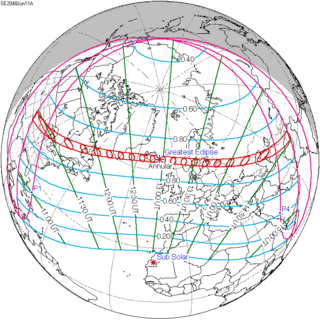| Solar eclipse of June 11, 2048 | |
|---|---|
| Type of eclipse | |
| Nature | Annular |
| Gamma | 0.6468 |
| Magnitude | 0.9441 |
| Maximum eclipse | |
| Duration | 298 s (4 min 58 s) |
| Coordinates | 63°42′N 11°30′W / 63.7°N 11.5°W |
| Max. width of band | 272 km (169 mi) |
| Times (UTC) | |
| Greatest eclipse | 12:58:53 |
| References | |
| Saros | 128 (60 of 73) |
| Catalog # (SE5000) | 9615 |
An annular solar eclipse will occur at the Moon's descending node of orbit on Thursday, June 11, 2048,[1] with a magnitude of 0.9441. A solar eclipse occurs when the Moon passes between Earth and the Sun, thereby totally or partly obscuring the image of the Sun for a viewer on Earth. An annular solar eclipse occurs when the Moon's apparent diameter is smaller than the Sun's, blocking most of the Sun's light and causing the Sun to look like an annulus (ring). An annular eclipse appears as a partial eclipse over a region of the Earth thousands of kilometres wide. Occurring only about 15.5 hours after apogee (on June 10, 2048, at 21:20 UTC), the Moon's apparent diameter will be smaller.[2]
The path of annularity will be visible from parts of Colorado, Kansas, the Oklahoma panhandle, Nebraska, northwestern Missouri, Iowa, southeastern Minnesota, northwestern Illinois, Wisconsin, and Michigan in the United States, eastern Canada, southern Greenland, Iceland, the Faroe Islands, Norway, Sweden, Estonia, Latvia, Lithuania, Belarus, western Russia, eastern Ukraine, southwestern Kazakhstan, southern Uzbekistan, Turkmenistan, southwestern Tajikistan, Afghanistan, and northern Pakistan. A partial solar eclipse will also be visible for parts of North America, Central America, the Caribbean, Europe, North Africa, the Middle East, and Central Asia.
- ^ "June 11, 2048 Annular Solar Eclipse". timeanddate. Retrieved 15 August 2024.
- ^ "Moon Distances for London, United Kingdom, England". timeanddate. Retrieved 15 August 2024.
